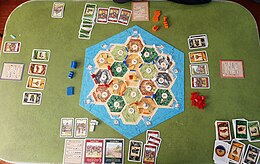Settlers of Catan
Settlers of CATAN, often called CATAN for short, is a board game created by Klaus Teuber in 1995 and now owned by Teuber's company, CATAN GmbH [1]. The goal of the game is for players to expand their settlements the fastest. As of 2022, 40 million copies of CATAN have been sold, and the game has been released in 40 languages.
Due to the success of CATAN, CATAN GmbH has released multiple spin-off versions, including CATAN Junior, a kid-friendly version of the original game, CATAN Starfarers, a space themed version of CATAN, and CATAN - Dawn of Humankind, an edition based off the evolution of humanity. In addition, scenarios and expansions have been released to be added to the base game. Scenarios add minor alterations to the base game, such as adding additional cards or having preset maps. Expansions add additional areas on the map and mechanics to the gameplay. Some expansions and scenarios can be combined for additional variety.
Gameplay[2]
The game containes hexagonal tiles that represent different terrains. Players begin setting up by randomly placing these on the matching outlines on the blue board. Numbered tiles are then randomly placed on all of the terrain tiles, except for the single tile with a desert on it. The robber piece is put on this desert tile. Players then take turns rolling a pair of dice; they put two house pieces, called settlements, in one of the corners around the corresponding hexagonal tile's number. Once each player has two houses on the board, the game is set up and the first player begins their turn.
During a player's turn, they roll the pair of dice. Any player who has a settlement around the hexagonal tile with the number rolled on it receives a resource corresponding to the type of terrain the tile is. The resources available in the base game are grain, wool, lumber, ore, and brick. During a player's turn, resources can be used to build settlements, roads leading from a player's own settlements, cities (upgraded from settlements), or development cards.
If a player rolls a seven, all players with more than seven resources in their hand must discard half of their cards. The player who rolled the dice then moves the robber token to another map tile, and the player may steal a resource from any other player who has a settlement adjacent to the tile the robber is on.
Development cards can be played at any point during a player's turn after the initial turn when the card is created. The player activating the card should read the instructions on the card based on what the card is.
During their turn, players can propose resource trades with other players or convert four of one type of resource to a resource of their choosing. They can also trade resources as listed at harbors, located on the coast of the map, if they have a settlement or city next to it.
The goal of the game is to earn victory points. Each settlement is worth one point, and each city is worth two. Some development cards award the player with a victory point. The player with the most knight cards (crafted from their development cards) played earns the "Largest Army" award, as long as they have more than three knights, and gains two extra victory points. The player with the longest continuous road (that is over five units long) gets the "Longest Road" award, and gains two extra victory points. The first player to collect ten victory points wins.
References
- ↑ About Us on the official Settlers of Catan website.
- ↑ CATAN Game Rules and Almanac, found on the CATAN website.

